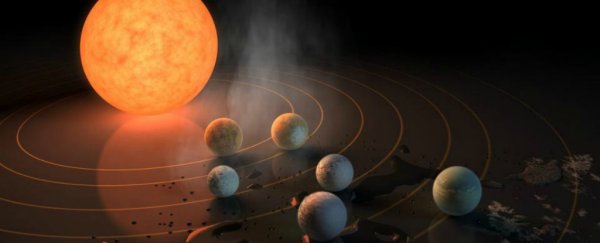A few weeks ago, NASA announced the discovery of seven, Earth-sized planets orbiting a star just 39 light-years away.
Known as the TRAPPIST-1 star system, the seven planets appear to be rocky, have life-friendly surface temperatures, and could potentially harbour liquid water - leading scientists to nickname it a 'sister solar system' to our own, and a pretty good spot to look for extraterrestrial life.
Since then, researchers have debated how habitable these planets could really be, given the stellar activity of the dwarf star they orbit.
But the truth is, until we get a closer look, no one can say for sure whether or not life could be supported somewhere in the star system. Which is why NASA has just rushed out data from its latest and longest observations of TRAPPIST-1 to date.
The initial discovery of the star system was made over several months last year, using a combination of NASA's Spitzer Space Telescope and ground-based telescopes.
But since 15 December 2016, NASA's had its own planet-hunting Kepler space telescope trained on TRAPPIST-1 for follow-up observations. And this week, they've made all that additional data freely available to the scientific community and public to trawl through. (Note: you need Python-based Kadenza software to extract the raw data files.)
In total, the observation period, which was part of Kepler's K2 Campaign, provided 74 days of monitoring, which is the longest, nearly continuous set of observations of TRAPPIST-1 to date.
Unfortunately, we can't tell you exactly what's in that gold mine of data just yet, because in its current state, it's totally raw and uncalibrated, and it's going to take weeks for scientists to make sense of what Kepler has seen.
But this early release gives scientists an opportunity to get more insight into the gravitational interaction between the planets - a clue to whether any of them are tidally locked - as well as the chance to spot any planets that may remain undiscovered in the system.
Interestingly, TRAPPIST-1 wasn't on Kepler's original list of systems to study last year. But in May 2016, when the discovery of the first three planets orbiting the star was announced, NASA decided to point it towards the constellation Aquarius, home of the TRAPPIST-1 system, to get a closer look.
Specifically, Kepler monitored minuscule changes in the star's brightness as the seven planets orbit in front of it.
That kind of 'dimming data' can give astronomers insight into the size and mass of the planets passing in front of their host star, and will hopefully help them nail down the orbital period of the seventh planet, which until now has only been observed passing in front of its star once.
The observations could also reveal information about the magnetic activity of the host star, which would greatly affect its habitable zone. That's why they've rushed out the data's release - NASA usually waits until its data has been processed before it gives us a look.
"Scientists and enthusiasts around the world are invested in learning everything they can about these Earth-size worlds," said Geert Barentsen, K2 research scientist at NASA's Ames Research Centre.
"Providing the K2 raw data as quickly as possible was a priority to give investigators an early look so they could best define their follow-up research plans. We're thrilled that this will also allow the public to witness the process of discovery."
And it's not just for the public's benefit - astronomers around the world are currently preparing proposals for where we should aim Earth-based telescopes next winter, which are due by the end of March.
Telescope spots are hard to secure, so the new TRAPPIST-1 data will hopefully give researchers enough ammo to convince regulatory bodies that they should be given time to observe the star system in the coming months.
If the raw data means very little to you - and, let's face it, if you're not used to looking at this type of data, it's like another language - don't worry. NASA plans to finish processing the data by late May, and will release a 'translated' version then, hopefully with some exciting discoveries for us.
Although Kepler observations are amazing, what the scientific community is even more excited about is the launch of the James Webb Space Telescope next year, which will be powerful enough to actually detect the atmospheric composition of the TRAPPIST-1 system.
In the meantime, thanks to this freely available data, it could be a member of the public who stumbles across the next big discovery in the star system, and that's pretty awesome.
You can see all the raw, unprocessed data here.
